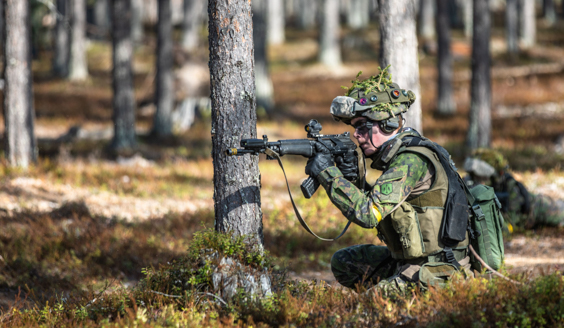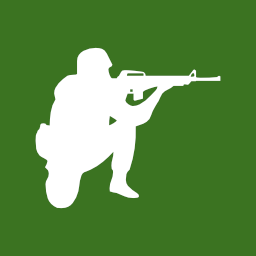Täytyy kyllä sanoa, että Bold Questissa kokeillaan ja testaillaan kaikennäköistä josta otetaan sitten oppia jatkokehittelyyn (mm. johtamista, viestintää, ilmatorjunnan omatunnistejärjestelmiä, ilmasta maahan vaikuttamista, simulaattorijärjestelmiä, jne. jne.)
Maavoimien simulaattorijärjestelmiä parannetaan Bold Questin kokemuksilla
Maavoimien simulaattoriosaamiskeskus tutkii Bold Quest 19.1 -tapahtumassa simulaattoreiden hyödyntämistä koulutuksessa ja kerää kokemuksia Puolustusvoimien tuleviin simulaattorihankkeisiin.
Saadut kokemukset simulaattoreiden käytöstä hyödynnetään kotimaan harjoitustoiminnan ja asevelvollisten koulutuksen nykyaikaisten menetelmien kehittämisessä.
Bold Quest 19.1 -tapahtuma järjestetään verkottuneessa simulaattoriympäristössä, ja siinä yhdistyvät oikea (live) ja eri tavoin simuloitu (virtuaalinen) toiminta.
Simulaattorit ovat laitteita tai ohjelmistoja, joilla kuvataan jotakin todellista laitetta tai toimintaa.
Tapahtuman aikana simulaattoreita tutkitaan live-ympäristössä Karjalan lennostossa Rissalassa ja Maavoimien harjoituksissa Pohjois-Suomessa sekä virtuaaliympäristössä,
jonka kautta tapahtumaan osallistuu henkilöstöä eri maista.
– Esimerkki live- ja virtuaaliympäristöjen yhdistämisestä on, että oikea lentokone lentää taivaalla, ja se näkyy taistelunjohtajan tilannekuvassa.
Samaan taistelun tilannekuvaan voidaan lisätä myös lentosimulaattorissa (simulaattorilaite maan pinnalla) lennettävä lentokone.
Tilannekuvassa näkyvät siis sekä oikea (live) lentokone että simuloitu (virtuaalinen) lentokone.
Maavoimissa voidaan vastaavasti harjoitella niin, että oikealle ilmatorjuntalavetille simuloidaan virtuaalinen maali, kuvaa tutkija Tuomas Munnukka Maavoimien simulaattoriosaamiskeskuksesta Lappeenrannasta.
Edellä kuvatussa esimerkissä lentokoneet, simulaattorit ja ilmatorjuntalavetit saattavat toimia eri maissa sijaitsevista tukikohdista ja harjoitusalueilta käsin.
Tietoverkon kautta ne ovat yhteydessä toisiinsa, ja niiden toiminnasta muodostetaan yhteistä tilannekuvaa.
– Oikeat ja virtuaaliset sotilaat, lentokoneet ja asejärjestelmät taistelevat siis maantieteellisesti pitkästä välimatkastaan huolimatta samassa virtuaalimaailmaan mallinnetussa taistelutilassa esimerkiksi Pohjois-
Suomessa, selittää Munnukka.
Simulaattorit tehostavat koulutusta
Bold Quest 19.1 -tapahtumassa live- ja virtuaaliympäristöjen tutkimuksen tavoitteena kerätä kokemuksia Puolustusvoimien tuleviin simulaattorihankkeisiin.
Tutkimuksessa seurataan, miten live- ja virtuaaliympäristöjä hyödynnetään.
– Tutkimus toteutetaan selvittämällä tapahtumaan osallistuvien kumppanimaiden kokemuksia ja parhaita käytänteitä simulaattoriympäristöjen koulutuskäytöstä.
Tämän pohjalta pohdimme, miten saaduilla kokemuksilla voidaan parantaa Maavoimien koulutusta entisestään, toteaa tutkija Munnukka.
Bold Quest 19.1 tarjoaa live- ja virtuaaliympäristöjen analysoinnille erittäin hyvän tutkimusalustan, sillä tapahtumaan osallistutaan laajasti eri puolilta maailmaa.
Tapahtumasta saadaan käytännön kokemuksia ympäristöjen hyödyntämisestä ja tutustutaan kansainvälisiin kollegoihin.
–
Näin suurta testitapahtumaa ei Suomessa ole aikaisemmin järjestetty.
Kansainvälinen tapahtuma tarjoaa näköalan samanaikaisesti usean valtion simulaattoritoimintaan ja heidän kokemuksiinsa, luonnehtii Munnukka tapahtuman hyötyjä tutkimukselle.
– Tarkoituksenamme on myös vahvistaa kansainvälistä asiantuntija- ja yhteistyöverkostoamme, mihin meillä on nyt ainutkertainen mahdollisuus, lisää Munnukka.
Tapahtumasta saadut kokemukset hyödynnetään täysimääräisesti Puolustusvoimien simulaattorihankkeissa tulevina vuosina.
-Tutustumme simulaattoriympäristössä toimimisen pelikenttään, haasteisiin ja pitkään simulaattoreita käyttäneiden maiden kokemuksiin.
Tiedonkeruun jälkeen otamme rinnalle Suomessa havaitsemiamme oman koulutuksemme kehittämiskohteita ja lähdemme työstämään ratkaisuja haasteisiin.
Meillä Maavoimien simulaattoriosaamiskeskuksessa on teknistä, pedagogista ja sotilastaktistakin osaamista, joten ongelmia ratkotaan useasta näkökulmasta, kertoo Munnukka.
Live- ja virtuaaliympäristöjen kehittäminen on tärkeää, koska hyvin suunnitellulla simulaattoriavusteisella harjoittelulla tehostetaan kotimaan harjoitustoimintaa ja asevelvollisten koulutusta.
Tehokkuus perustuu siihen, ettei toistojen osuutta tarvitse rajata esimerkiksi ampumatarvikkeiden määrän tai valoisan ajan perusteella.
Harjoittelua virtuaaliympäristössä eivät myöskään rajoita maantieteelliset etäisyydet, alueiden käyttö tai kaluston saatavuus.
– Toiminta voidaan viedä pidemmälle kuin oikeissa live-harjoituksissa.
Joukot pystytään esimerkiksi siirtämään sellaisille alueille, joita ei muutoin harjoituksissa voitaisi käyttää.
Kustannussäästöjäkin syntyy, kun kalustoa ei tarvitse siirtää ja ajankäyttö tehostuu, huomauttaa Munnukka.
Virtuaalikoulutusympäristöjen kehittämisessä ei ole yhtä oikeaa reittiä.
Kenttäkouluttajilta saatavat kokemukset ja palaute kuitenkin ohjaavat simulaattoreiden kehitystä, sillä ne kehitetään käyttäjien tarpeisiin.
– Avainsanoja ovat rohkeus kokeilla ja avoin asenne.
Simulaattoreilla ja virtuaalikoulutusympäristöillä on paljon annettavaa koulutukseen, mutta yksin niiden varaan koulutusta ei voida rakentaa, painottaa Munnukka.
Simulaattoreita hyödynnetään laajasti
Simulaattoreiden rooli koulutuksessa on merkittävä. Puolustusvoimissa simulaattoreita hyödynnetään lähes kaikkien asejärjestelmien koulutuksessa.
Esimerkkinä panssarivaunujen ajamisen, panssarivaunujen järjestelmien käytön sekä huollon koulutuksessa ja taisteluharjoituksissa Suomessa ja ulkomailla.
Simulaattorit jaotellaan toimintaperiaatteensa mukaan kolmeen ryhmään:
livesimulaattoreihin,
virtuaalisimulaattoreihin ja
konstruktiivisiin simulaattoreihin.
Maavoimat käyttää kaikkia kolmea simulaattorityyppiä: livesimulaattori Kasi, taistelutilan virtuaalisimulaattori VBS (Virtual Battle Space = virtuaalinen taistelutila) ja
konstruktiivinen simulaattori Kesi (esikuntasimulaattori).
-Esimerkiksi taisteluharjoituksissa käytössä on kaksipuolinen taistelun simulointijärjestelmä Kasi, jonka avulla yksittäinen sotilas saa tiedon osumasta tai läheltä menneestä laukauksesta ja toisaalta joukko saa palautetta taistelutoiminnan onnistumisesta.
Virtuaalisimulaattoreihin (VBS) kuuluvia virtuaalikoulutusympäristöjä on rakennettu joukko-osastoihin viime vuosina.
Virtuaalikoulutusympäristössä voidaan harjoitella toimintaa ennen oikeaa maastoharjoitusta, kertoo Munnukka.
Konstruktiivista simulaattoria Kesiä käytetään komentajien ja esikuntien kouluttamisessa.
Käytännössä maastossa ei ole oikeita joukkoja, vaan kaikki joukot, toiminta ja maasto ovat simuloituja.
Kansainvälisiin harjoituksiin on osallistuttu käyttämällä yksittäisiä simulaattoreita kuten Kasi-simulaattorijärjestelmää.
– Suomalaisten simulaattorit toimivat pitkälti samoin periaattein kuin kansainvälisten kumppaneiden laitteet. Valmius simulaattoriavusteiseen yhteisharjoitteluun on siis hyvä.
Järjestelmät kuitenkin kehittyvät ja hankimme uutta simulaattorikalustoa, joten järjestelmien kansainvälisen yhteensopivuuden varmistamiseen tarvitaan Bold Questin kaltaisia tapahtumia,
päättää tutkija Munnukka.

















